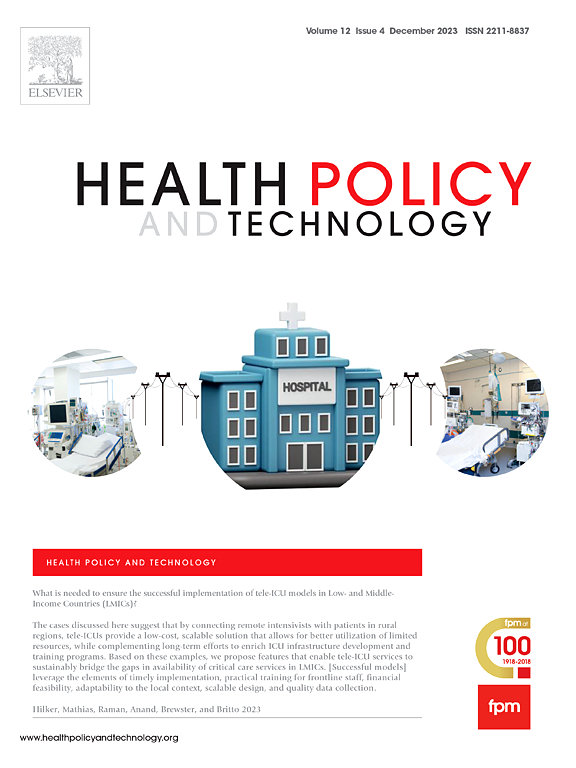Dimensions and criteria of value assessment frameworks for generic drugs: A scoping review and thematic analysis
IF 3.7
3区 医学
Q1 HEALTH POLICY & SERVICES
引用次数: 0
Abstract
Objectives
Although generic drugs offer comparable patient benefits and cost advantages to original drugs and are widely utilized in emerging nations, concerns persist regarding their product quality, bioequivalence, and clinical outcomes. Additionally, there is a lack of consensus on the value assessment for generic drugs, particularly in determining whether lower prices correspond to equivalent value. Our objective is to systematically describe and contrast the prevailing tools, scales, frameworks and etc. for assessing generic drugs, while integrating their core dimensions and criteria as a reference for emerging nations. Methods: This study systematically reviewed evaluation tools, scales, and frameworks etc. for generic or off-patent drugs. Given that meta-analysis is limited to qualitative research, thematic analysis was employed to comprehensively synthesize the primary concepts of generic drug evaluation. The literature search was conducted using PubMed, EMbase, CNKI, and WanFang Data, with a cut-off date of July 25, 2024. Additionally, thematic analysis was conducted to identify themes and subthemes related to the evaluation of generics across the included records. Results: A total of nine evaluation tools, scales, and frameworks for generic drugs were included in this study. Variations were observed in their dimensions, criteria, application procedures, and methods of calculating criteria weights among participants. Ultimately, four core themes and 16 subthemes for the evaluation of generics were synthesized through thematic analysis. Conclusions: The four themes and sixteen subthemes can be regarded as primary dimensions and criteria for evaluating the value of generic drugs. They serve as a benchmark for value assessment frameworks, thereby promoting advancements in healthcare systems in regions where generic drugs are widely utilized.
Public Interest Summary
Although generic drugs provide comparable patient benefits and cost advantages to original drugs and are widely used in emerging nations, concerns persist regarding their product quality, bioequivalence, and clinical outcomes. Our objective is to systematically describe and contrast the prevailing tools, scales, frameworks, and other relevant methodologies for assessing generic drugs, while integrating their core dimensions and criteria. This study incorporates a total of nine evaluation tools, scales, and frameworks for generic drugs, synthesizing them into four core themes and 16 subthemes for the evaluation of generics. These four themes and sixteen subthemes can be regarded as primary dimensions and criteria for assessing the value of generic drugs. They serve as a benchmark for value assessment frameworks, thereby promoting advancements in healthcare systems in regions where generic drugs are widely utilized.
仿制药价值评估框架的维度和标准:范围审查和专题分析
虽然仿制药提供了与原研药相当的患者利益和成本优势,并且在新兴国家被广泛使用,但对其产品质量、生物等效性和临床结果的担忧仍然存在。此外,对仿制药的价值评估缺乏共识,特别是在确定较低的价格是否相当于同等价值方面。我们的目标是系统地描述和对比用于评估仿制药的主流工具、规模、框架等,同时整合其核心维度和标准,作为新兴国家的参考。方法:本研究系统地回顾了仿制药和非专利药的评价工具、量表和框架等。由于meta分析仅限于定性研究,故采用专题分析对仿制药评价的主要概念进行综合。文献检索使用PubMed、EMbase、CNKI和万方数据,截止日期为2024年7月25日。此外,还进行了专题分析,以确定与所包括记录的一般评价有关的专题和次级专题。结果:本研究共纳入9种仿制药评价工具、量表和框架。在维度、标准、应用程序和计算标准权重的方法上观察到参与者之间的差异。通过专题分析,最终合成了4个核心专题和16个分专题。结论:4个主题和16个副主题可作为评价仿制药价值的主要维度和标准。它们可作为价值评估框架的基准,从而促进广泛使用仿制药的地区卫生保健系统的进步。尽管仿制药提供了与原研药相当的患者利益和成本优势,并且在新兴国家广泛使用,但对其产品质量、生物等效性和临床结果的担忧仍然存在。我们的目标是系统地描述和对比评估仿制药的主流工具、量表、框架和其他相关方法,同时整合其核心维度和标准。本研究共纳入了9个仿制药评价工具、量表和框架,将其合成为4个核心主题和16个副主题,用于仿制药评价。这四个主题和十六个次级主题可以看作是评估仿制药价值的主要维度和标准。它们可作为价值评估框架的基准,从而促进广泛使用仿制药的地区卫生保健系统的进步。
本文章由计算机程序翻译,如有差异,请以英文原文为准。
求助全文
约1分钟内获得全文
求助全文
来源期刊

Health Policy and Technology
Medicine-Health Policy
CiteScore
9.20
自引率
3.30%
发文量
78
审稿时长
88 days
期刊介绍:
Health Policy and Technology (HPT), is the official journal of the Fellowship of Postgraduate Medicine (FPM), a cross-disciplinary journal, which focuses on past, present and future health policy and the role of technology in clinical and non-clinical national and international health environments.
HPT provides a further excellent way for the FPM to continue to make important national and international contributions to development of policy and practice within medicine and related disciplines. The aim of HPT is to publish relevant, timely and accessible articles and commentaries to support policy-makers, health professionals, health technology providers, patient groups and academia interested in health policy and technology.
Topics covered by HPT will include:
- Health technology, including drug discovery, diagnostics, medicines, devices, therapeutic delivery and eHealth systems
- Cross-national comparisons on health policy using evidence-based approaches
- National studies on health policy to determine the outcomes of technology-driven initiatives
- Cross-border eHealth including health tourism
- The digital divide in mobility, access and affordability of healthcare
- Health technology assessment (HTA) methods and tools for evaluating the effectiveness of clinical and non-clinical health technologies
- Health and eHealth indicators and benchmarks (measure/metrics) for understanding the adoption and diffusion of health technologies
- Health and eHealth models and frameworks to support policy-makers and other stakeholders in decision-making
- Stakeholder engagement with health technologies (clinical and patient/citizen buy-in)
- Regulation and health economics
 求助内容:
求助内容: 应助结果提醒方式:
应助结果提醒方式:


